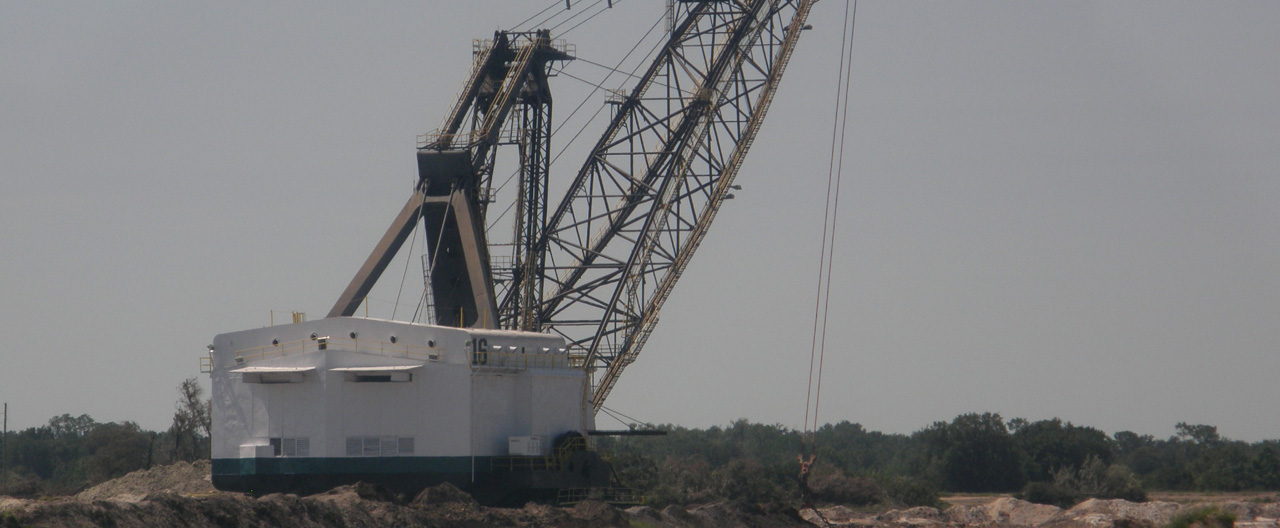Air Quality
Fluoride emissions:
- Fluoride is in the phosphate mineral “fluorapatite” that is mined in Florida. Fluoride
in small doses, like in the fluoride in our toothpaste, is beneficial to our health
and can strengthen our bones and teeth. In large doses, however, it can cause tooth
mottling and even deterioration of bones (fluorosis). Phosphate companies historically
have had scrubbers in the stacks of their chemical processing plants, but in the 1960s
cases of citrus damage and fluorosis in area cattle caused regulators to tighten the
restrictions on fluoride emissions. Since that time phosphate companies have improved
their scrubbing techniques and today fluoride emissions are not considered to be a
problem. It is scrubbed from the stack and is either recovered to make fluosilic acid,
which can be sold for uses such as water fluoridation, or is sent to the cooling pond.
Radon gas:
- We live amongst natural radiation all day every day. In fact, humans themselves are
radioactive because of the radioactive atoms naturally present in their bodies. In
Florida there are radioactive elements, such as the uranium, found in the earth with
the phosphate. Radon gas is part of the natural decay chain of uranium as one radioactive
atom decays to another and then another until a final stable atom is reached. In mined
areas the radon levels may be higher than in other areas because during mining the
more radioactive earth may end up closer to the surface and when the earth is broken
by mining it is easier for the radon gas to escape.
The increase in the amount of radon gas outdoors due to phosphate mining poses no threat to human health or the environment because it rapidly disperses as it rises in the atmosphere such that it is not detectable. Scientists who measure radon escaping the ground must use special chambers to capture it at the ground surface. The buildup of radon in a closed house is of more concern and is the subject of much scientific debate. Please see the section on “Land” for more details.
Dusts from rock storage, product storage and phosphogypsum stacks:
- As you might think, an industry that deals with crushed rock and dry granulated products
puts some dust in the air. The mining sites use water to transport ore, so dust isn’t
an issue during transportation of matrix. In the processing plants more dry materials
are handled, but the dust is only an on-site concern. Dust can be an irritant and
can contain naturally radioactive particles, so workers in dusty areas wear dust masks.
The dust connected to the processing and storage of phosphate rock was never a big
health concern and changes in the way the rock is processed and handled has made it
even less likely to cause a problem.
In the 1970s the industry stopped drying rock before processing it and went to a wet rock grinding process that eliminated dust problems. Dust released as products are moved and stored was greatly reduced in the 1980s when the industry began coating its products with oil. FIPR did some of the research in this area. It can be hard to see when heavy equipment kicks a lot of dust into the air, and accidents can be reduced when dust is controlled.
SO2 emissions:
- The SO2 (sulfur dioxide) emitted from sulfuric acid operations at phosphate chemical
processing plants is very low compared to that emitted from power plants. It is, however,
highly regulated because in high enough concentrations it could cause severe damage
to the respiratory system. The emissions have dropped significantly since the 1980s
because phosphate companies started operating double absorption plants and began recovering
more of the valuable sulfur in the SO2 to make sulfuric acid.
Companies, however, have extensive safety plans in place in case of an accidental release. Such plans include alarm protocols and shelter-in-place training for the surrounding community.
On May 5 2003 some of these alarms went off in Plant City warning residents around the CF Industries’ chemical processing plant that there has been a gaseous release. The incident turned out to be minor with no reports of injuries inside or outside the plant. The release occurred when Tampa Electric Co. shut off power to the plant. CF Industries is an “interruptible” customer, which means it may be cut off when electric supplies are tight due to demand or other causes. CF had about 11 minutes notice that it would lose power and the company’s own power generator could not do its back-up job because it was down for routine maintenance. When the power went out a blower did not shut off properly and sent the sulfur trioxide gas out of the plant’s stack.
Noise:
- Hearing protection is an important issue for mining, beneficiation and chemical processing
sites. Environmental health and safety staffs are diligent about posting areas where
hearing protection is required, instructing workers on how to properly select and
wear hearing protection, and monitoring to ensure workers are using the protective
gear appropriately. FIPR sponsored a study that considered noise and vibration at
plant perimeters for members of the public. The study measured typical levels of noise
and vibration at mine boundaries near draglines and made recommendations about how
to reduce those levels. For workers on the plant sites, regulatory limits for noise
exposure have recently changed to be even more restrictive and protective.
